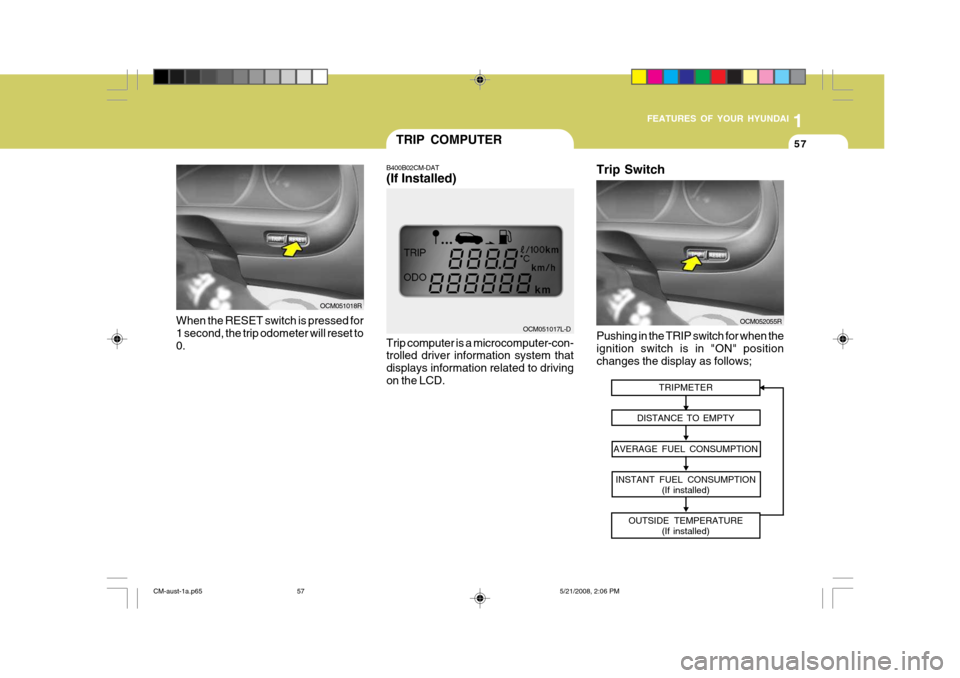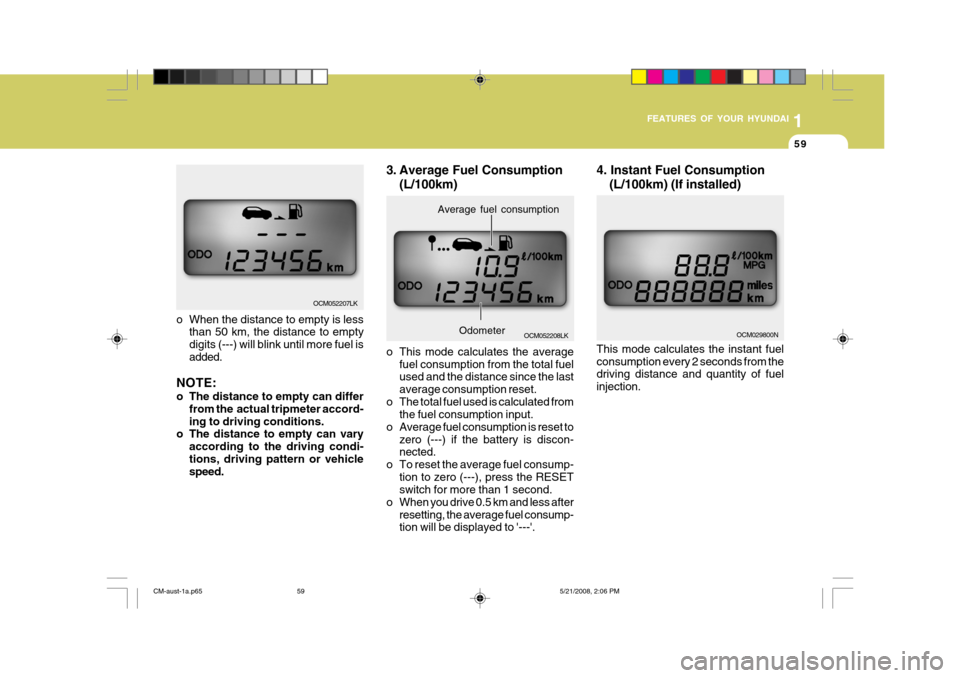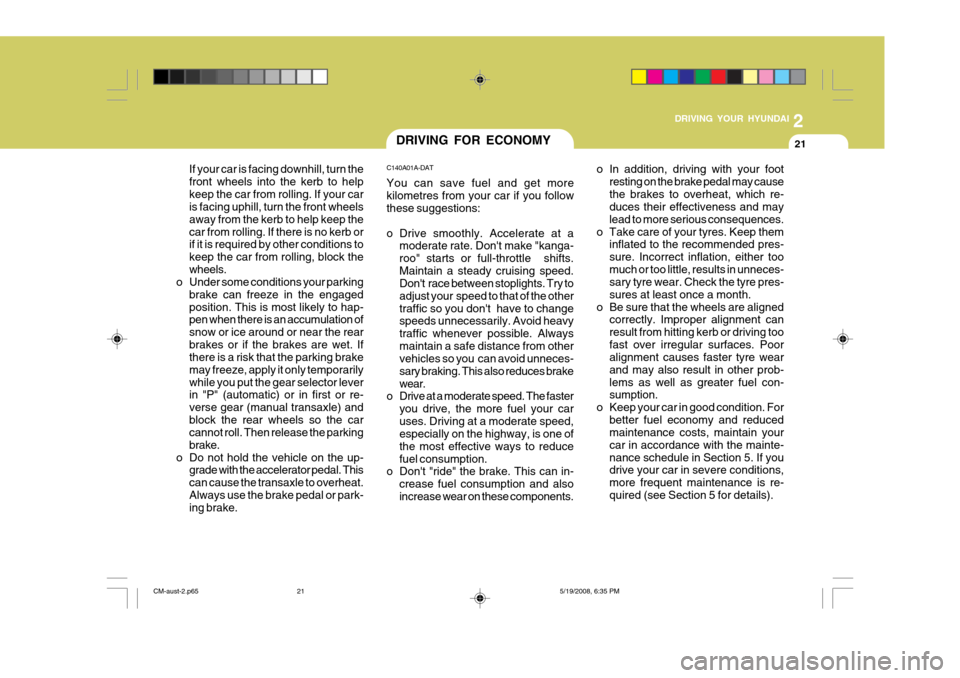fuel consumption Hyundai Santa Fe 2009 Owner's Manual - RHD (UK, Australia)
[x] Cancel search | Manufacturer: HYUNDAI, Model Year: 2009, Model line: Santa Fe, Model: Hyundai Santa Fe 2009Pages: 269, PDF Size: 9.78 MB
Page 68 of 269

1
FEATURES OF YOUR HYUNDAI
57
OCM051018R
When the RESET switch is pressed for 1 second, the trip odometer will reset to0.
TRIP COMPUTER
B400B02CM-DAT (If Installed) Trip computer is a microcomputer-con- trolled driver information system that displays information related to drivingon the LCD. OCM051017L-D
Pushing in the TRIP switch for when the ignition switch is in "ON" position changes the display as follows;
OCM052055R
Trip Switch
TRIPMETER
DISTANCE TO EMPTY
AVERAGE FUEL CONSUMPTION INSTANT FUEL CONSUMPTION (If installed)
OUTSIDE TEMPERATURE (If installed)
CM-aust-1a.p65 5/21/2008, 2:06 PM
57
Page 70 of 269

1
FEATURES OF YOUR HYUNDAI
59
OCM052207LK
o When the distance to empty is less than 50 km, the distance to empty digits (---) will blink until more fuel isadded.
NOTE:
o The distance to empty can differ from the actual tripmeter accord- ing to driving conditions.
o The distance to empty can vary
according to the driving condi-tions, driving pattern or vehicle speed.
OCM052208LK
Average fuel consumption
Odometer
3. Average Fuel Consumption
(L/100km)
o This mode calculates the average fuel consumption from the total fuel used and the distance since the last average consumption reset.
o The total fuel used is calculated from the fuel consumption input.
o Average fuel consumption is reset to zero (---) if the battery is discon- nected.
o To reset the average fuel consump- tion to zero (---), press the RESETswitch for more than 1 second.
o When you drive 0.5 km and less after resetting, the average fuel consump-tion will be displayed to '---'. 4. Instant Fuel Consumption
(L/100km) (If installed)
This mode calculates the instant fuel consumption every 2 seconds from the driving distance and quantity of fuel injection.OCM029800N
CM-aust-1a.p65 5/21/2008, 2:06 PM
59
Page 166 of 269

2
DRIVING YOUR HYUNDAI
21
If your car is facing downhill, turn the front wheels into the kerb to helpkeep the car from rolling. If your car is facing uphill, turn the front wheels away from the kerb to help keep thecar from rolling. If there is no kerb or if it is required by other conditions to keep the car from rolling, block thewheels.
o Under some conditions your parking
brake can freeze in the engagedposition. This is most likely to hap- pen when there is an accumulation of snow or ice around or near the rearbrakes or if the brakes are wet. If there is a risk that the parking brake may freeze, apply it only temporarilywhile you put the gear selector lever in "P" (automatic) or in first or re- verse gear (manual transaxle) andblock the rear wheels so the car cannot roll. Then release the parking brake.
o Do not hold the vehicle on the up- grade with the accelerator pedal. Thiscan cause the transaxle to overheat.Always use the brake pedal or park- ing brake.DRIVING FOR ECONOMY
C140A01A-DAT You can save fuel and get more kilometres from your car if you follow these suggestions:
o Drive smoothly. Accelerate at a moderate rate. Don't make "kanga- roo" starts or full-throttle shifts.Maintain a steady cruising speed. Don't race between stoplights. Try to adjust your speed to that of the othertraffic so you don't have to change speeds unnecessarily. Avoid heavy traffic whenever possible. Alwaysmaintain a safe distance from other vehicles so you can avoid unneces- sary braking. This also reduces brakewear.
o Drive at a moderate speed. The faster
you drive, the more fuel your caruses. Driving at a moderate speed, especially on the highway, is one of the most effective ways to reducefuel consumption.
o Don't "ride" the brake. This can in-
crease fuel consumption and alsoincrease wear on these components. o In addition, driving with your foot
resting on the brake pedal may causethe brakes to overheat, which re- duces their effectiveness and may lead to more serious consequences.
o Take care of your tyres. Keep them inflated to the recommended pres-sure. Incorrect inflation, either toomuch or too little, results in unneces- sary tyre wear. Check the tyre pres- sures at least once a month.
o Be sure that the wheels are aligned correctly. Improper alignment canresult from hitting kerb or driving toofast over irregular surfaces. Poor alignment causes faster tyre wear and may also result in other prob-lems as well as greater fuel con- sumption.
o Keep your car in good condition. For better fuel economy and reducedmaintenance costs, maintain your car in accordance with the mainte-nance schedule in Section 5. If you drive your car in severe conditions, more frequent maintenance is re-quired (see Section 5 for details).
CM-aust-2.p65 5/19/2008, 6:35 PM
21